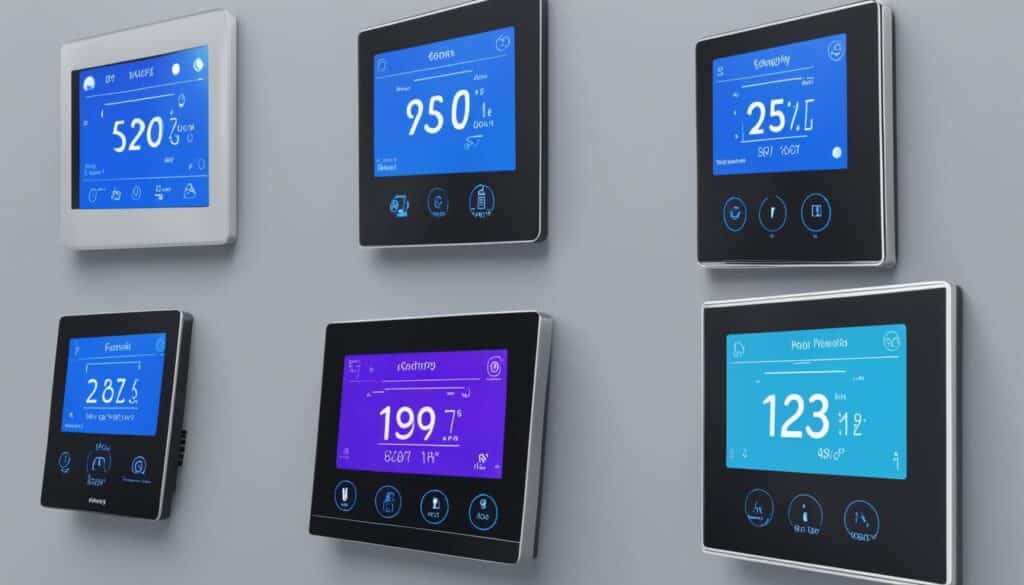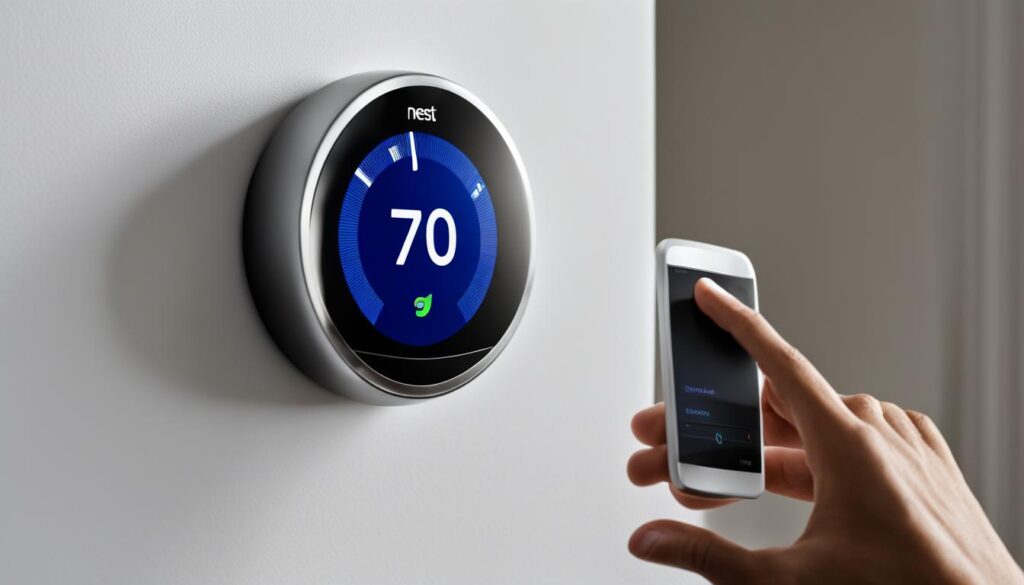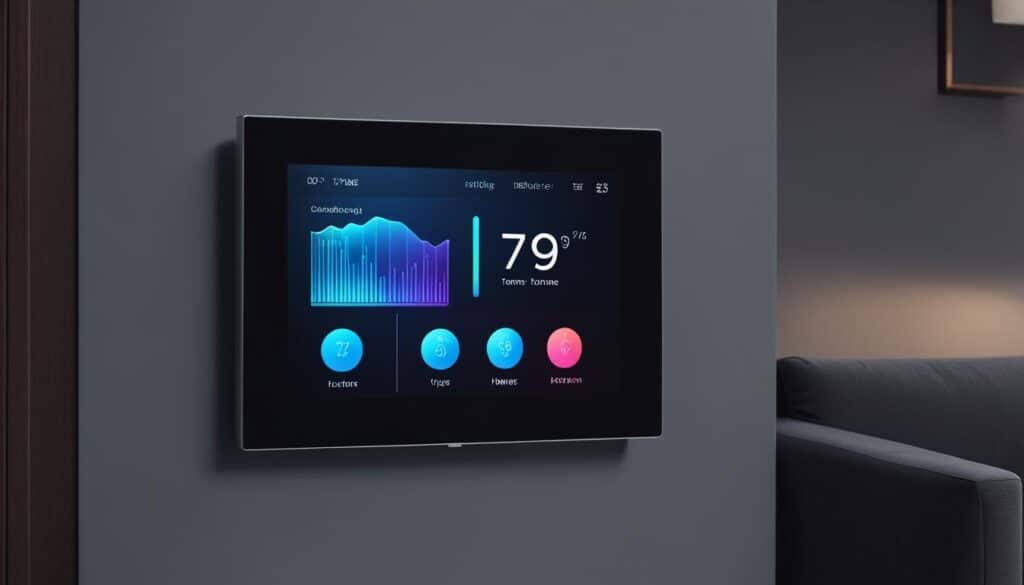Smart home heating controls are a convenient and energy-efficient way to manage the temperature in your home. With the advancement of technology, these controls have become more accessible and user-friendly for beginners. In this guide, I will walk you through everything you need to know about getting started with smart home heating controls.
Table of Contents
Key Takeaways
- Smart home heating controls offer convenience and energy efficiency for beginners.
- They provide greater control over the temperature in your home and can be adjusted remotely.
- Smart controls help you save on energy costs and provide insights into your energy usage.
- There are various types of smart home heating controls available, such as thermostats and radiator valves.
- Installing and setting up smart controls is relatively straightforward, but it’s important to follow the manufacturer’s instructions.
Why Choose Smart Home Heating Controls?
When it comes to managing the temperature in your home, smart home heating controls offer a range of advantages that make them a great choice. Whether you’re looking to enhance comfort, save on energy costs, or gain valuable insights into your energy usage, these controls have got you covered. Let’s delve into the key advantages of smart home heating controls:
Greater Control and Comfort
With smart home heating controls, you have the power to customize the temperature settings in your home according to your preferences. Whether you prefer a cozy warm environment or a slightly cooler ambiance, smart controls give you the flexibility to adjust the temperature with ease. Imagine waking up to a toasty home in the morning or coming back from work to a cozy living room—smart controls make it all possible.
Energy Savings
Smart home heating controls bring energy efficiency to a whole new level. By allowing you to schedule heating cycles and adjust settings remotely, these controls enable you to optimize energy usage based on your needs. For example, you can set the temperature to lower during the hours when you’re away from home and raise it back up just before you return, ensuring comfort while minimizing wastage. This level of control can lead to significant savings on your energy bills in the long run.
Insights into Energy Usage
One of the lesser-known advantages of smart home heating controls is their ability to provide valuable insights into your energy usage. By monitoring and analyzing your heating patterns, these controls offer detailed information on how and when energy is consumed in your home. This data empowers you to make informed decisions on improving energy efficiency and reducing wastage. It’s like having a personal energy advisor right at your fingertips.
“Smart home heating controls offer a range of advantages, from greater comfort and energy savings to valuable insights into your energy usage.”
Overall, smart home heating controls are a smart investment for anyone looking to optimize their home’s temperature management. With greater control, energy savings, and valuable insights, these controls put you in charge of your home’s comfort and efficiency.
| Advantages | Description |
|---|---|
| Greater Control and Comfort | Customize temperature settings according to preferences |
| Energy Savings | Schedule heating cycles and adjust settings remotely to optimize energy usage |
| Insights into Energy Usage | Monitor and analyze heating patterns to make informed decisions about energy efficiency |
Types of Smart Home Heating Controls
When it comes to smart home heating controls, there are various types available on the market. Each type offers different features and benefits that cater to specific needs. Here are some popular options:
Smart Thermostats
Smart thermostats have gained widespread popularity due to their ease of use and convenience. With a smart thermostat, you can effortlessly control the temperature in your home using a smartphone app or voice commands. These intuitive devices allow you to adjust settings remotely, create heating schedules, and monitor energy usage. Some models even have learning capabilities, adapting to your preferences over time.
Smart Radiator Valves
If you’re looking for individual room temperature control, smart radiator valves are an excellent choice. These valves can be installed on each radiator in your home, allowing you to adjust the temperature in specific rooms. With the help of a smartphone app or central control system, you can easily manage and optimize the heating in each area. This level of control helps to save energy and increase comfort by providing personalized heating settings.
Smart Heating Systems
For those who prefer a comprehensive heating solution, smart heating systems offer centralized control over the entire house. These systems typically consist of a main control unit that connects to your heating equipment, such as a boiler or heat pump. Smart heating systems enable you to manage the temperature settings for the entire home, adjust heating schedules, and monitor energy consumption. They provide a holistic approach to heating control, ensuring consistent comfort throughout your living spaces.
Choosing the right type of smart home heating control depends on your specific needs and preferences. Consider factors such as the size of your home, the level of control you desire, and your budget. Consulting with a professional and doing thorough research can help you make an informed decision.

| Type | Features | Benefits |
|---|---|---|
| Smart Thermostats | – Smartphone app control – Voice commands – Energy monitoring | – Greater convenience – Energy savings – Personalized comfort |
| Smart Radiator Valves | – Individual room control – Smartphone app control – Temperature optimization | – Energy efficiency – Customized comfort – Zoned heating |
| Smart Heating Systems | – Centralized control – Heating schedule management – Energy consumption monitoring | – Whole-house comfort – Energy savings – Simplified control |
Installing Smart Home Heating Controls
Installing smart home heating controls is a straightforward process that can be easily accomplished. Most systems come with detailed installation instructions, ensuring a hassle-free setup. Additionally, many manufacturers provide video tutorials and step-by-step guides to assist you. Following the manufacturer’s instructions carefully is essential for proper installation and optimal functionality.
When installing smart home heating controls, the first step is to replace your existing thermostat or radiator valves with the new smart controls. This may involve disconnecting the old controls and removing them from the wall or radiator. Be sure to turn off the power before beginning the installation process to ensure safety.
Next, you will need to connect the smart controls to your home’s Wi-Fi network. This allows you to control and monitor your heating system remotely through a smartphone app or online platform. The specific steps for connecting to Wi-Fi may vary depending on the brand and model of your chosen smart controls.
Once the smart controls are properly installed and connected to Wi-Fi, you can proceed with configuring the settings and personalizing your heating preferences. This may include setting up temperature schedules, adjusting temperature limits, and exploring additional features offered by the smart controls.
Remember, if you are uncertain or uncomfortable with the installation process, it’s always best to consult a professional electrician or heating engineer. They can ensure a safe and proper installation, giving you peace of mind and ensuring the optimal performance of your smart home heating controls.
Setting Up and Programming Smart Home Heating Controls
Once your smart home heating controls are installed, it’s time to set them up and program them to suit your preferences. This step is crucial in optimizing your smart controls for efficient temperature management and energy savings.
First, you’ll need to connect your smart controls to a smartphone app or online platform provided by the manufacturer. This allows you to access and control your heating system remotely, even when you’re away from home.
Using the app or online platform, you can adjust temperature settings in real-time, ensuring your home is always cozy and comfortable. Additionally, you can create heating schedules based on your daily routine. This means you can program your smart controls to lower the temperature during times when you’re typically not at home, such as when you’re at work or asleep. By doing this, you can save on energy costs while still returning to a warm and cozy home.
Many smart home heating controls come with advanced features that further enhance their functionality. For example, some controls offer geofencing, which automatically adjusts the temperature based on your location. This means that as you leave your home, the controls will lower the temperature to save energy, and as you approach your home, they will raise the temperature to ensure a comfortable environment upon your arrival.

Another advanced feature to look out for is learning algorithms. These algorithms analyze your heating habits and preferences over time, allowing the controls to adapt and make automatic adjustments for optimized comfort and energy efficiency.
It’s important to note that the specific setup and programming process may vary depending on the brand and model of your smart home heating controls. Always refer to the manufacturer’s instructions and user guides for detailed steps on how to set up and program your specific controls.
Benefits of Setting Up Smart Home Heating Controls
By setting up and programming your smart home heating controls, you can enjoy a range of benefits, including:
- Increased comfort: Adjust the temperature to your desired level and schedule heating cycles to match your routine.
- Energy savings: Create heating schedules tailored to your lifestyle, lowering the temperature when you’re away or asleep to reduce energy consumption.
- Remote access: Control your heating system from anywhere using a smartphone app or online platform.
- Advanced features: Take advantage of features like geofencing and learning algorithms to optimize temperature control and energy efficiency.
- Insights and data: Monitor your energy usage and receive valuable insights to make informed decisions about your heating habits.
Overall, setting up and programming your smart home heating controls empowers you to have greater control over your home’s temperature, save on energy costs, and enjoy a more comfortable living space.
Troubleshooting and Maintenance of Smart Home Heating Controls
While smart home heating controls are designed to be user-friendly, occasional issues may arise, and maintenance may be required to ensure optimal performance. Here are some troubleshooting tips and maintenance tasks to keep your smart home heating system running smoothly:
Troubleshooting Tips
- Check Wi-Fi Connectivity: Ensure that your smart home heating controls are connected to a stable Wi-Fi network. Poor connectivity can affect the controls’ ability to communicate and function properly.
- Power and Connection: Confirm that your controls are powered on and properly connected. Loose cables or faulty power sources can disrupt the system’s operation.
- Software/Firmware Updates: Regularly check for software or firmware updates for your smart home heating controls. Manufacturers often release updates to improve functionality and address any known issues or vulnerabilities.
Maintenance Tasks
- Replace Batteries: If you have a smart thermostat, it may require batteries to operate. Periodically check the battery levels and replace them as needed to ensure uninterrupted functionality.
- Adjust Radiator Valves: If you have smart radiator valves, monitor their performance and adjust them as necessary to maintain the desired temperature in each room.
Remember, it’s important to consult the manufacturer’s instructions for specific troubleshooting steps and maintenance guidelines. By addressing any issues promptly and performing regular maintenance tasks, you can maximize the effectiveness and efficiency of your smart home heating controls.
Conclusion
In conclusion, smart home heating controls offer a wide range of benefits for beginners who are looking to efficiently manage the temperature in their homes. These controls not only provide increased comfort but also help save on energy costs by allowing you to schedule heating cycles and adjust settings remotely.
With the ability to tailor the temperature to your preferences and gain valuable insights into your energy usage, smart home heating controls enhance your overall home heating experience. By choosing the right type of control and following the installation and setup instructions, you can easily enjoy the convenience and energy efficiency that these controls provide.
Additionally, regular maintenance and troubleshooting can help ensure optimal performance. By consulting the manufacturer’s instructions and performing necessary tasks such as software updates or battery replacements, you can keep your smart home heating controls running smoothly.
In summary, smart home heating controls empower beginners to take control of their home’s temperature, offering comfort, cost savings, and greater energy efficiency. With their user-friendly features and advancements in technology, these controls are an excellent choice for anyone looking to create a more comfortable and sustainable living environment.
FAQ
Are smart home heating controls suitable for beginners?
Yes, smart home heating controls have become more accessible and user-friendly for beginners. They come with detailed installation instructions and many manufacturers provide video tutorials or step-by-step guides.
What are the advantages of choosing smart home heating controls?
Smart home heating controls offer greater control over the temperature in your home, making it more comfortable and tailored to your preferences. They can help you save on energy costs by allowing you to schedule heating cycles and adjust settings remotely. Smart controls also provide valuable insights into your energy usage, helping you make more informed decisions about efficiency.
What types of smart home heating controls are available?
There are various types of smart home heating controls available, including smart thermostats, smart radiator valves, and smart heating systems. Each type offers different features and benefits, so it’s important to choose one that suits your needs.
How do I install smart home heating controls?
Most systems come with detailed installation instructions, and many manufacturers provide video tutorials or step-by-step guides. Generally, the process involves replacing your existing thermostat or radiator valves with the smart controls and connecting them to your home’s Wi-Fi network. It’s important to follow the manufacturer’s instructions carefully to ensure proper installation and functionality.
How do I set up and program smart home heating controls?
Setting up and programming smart home heating controls typically involves connecting the controls to a smartphone app or online platform. From there, you can adjust temperature settings, create heating schedules, and monitor energy usage. Many smart controls also offer advanced features such as geofencing and learning algorithms.
What should I do if I encounter issues with my smart home heating controls?
If you encounter issues, common troubleshooting steps include checking your Wi-Fi connectivity, ensuring the controls are powered on and properly connected, and updating the control software or firmware. Regular maintenance tasks such as replacing batteries or adjusting radiator valves may also be necessary.


